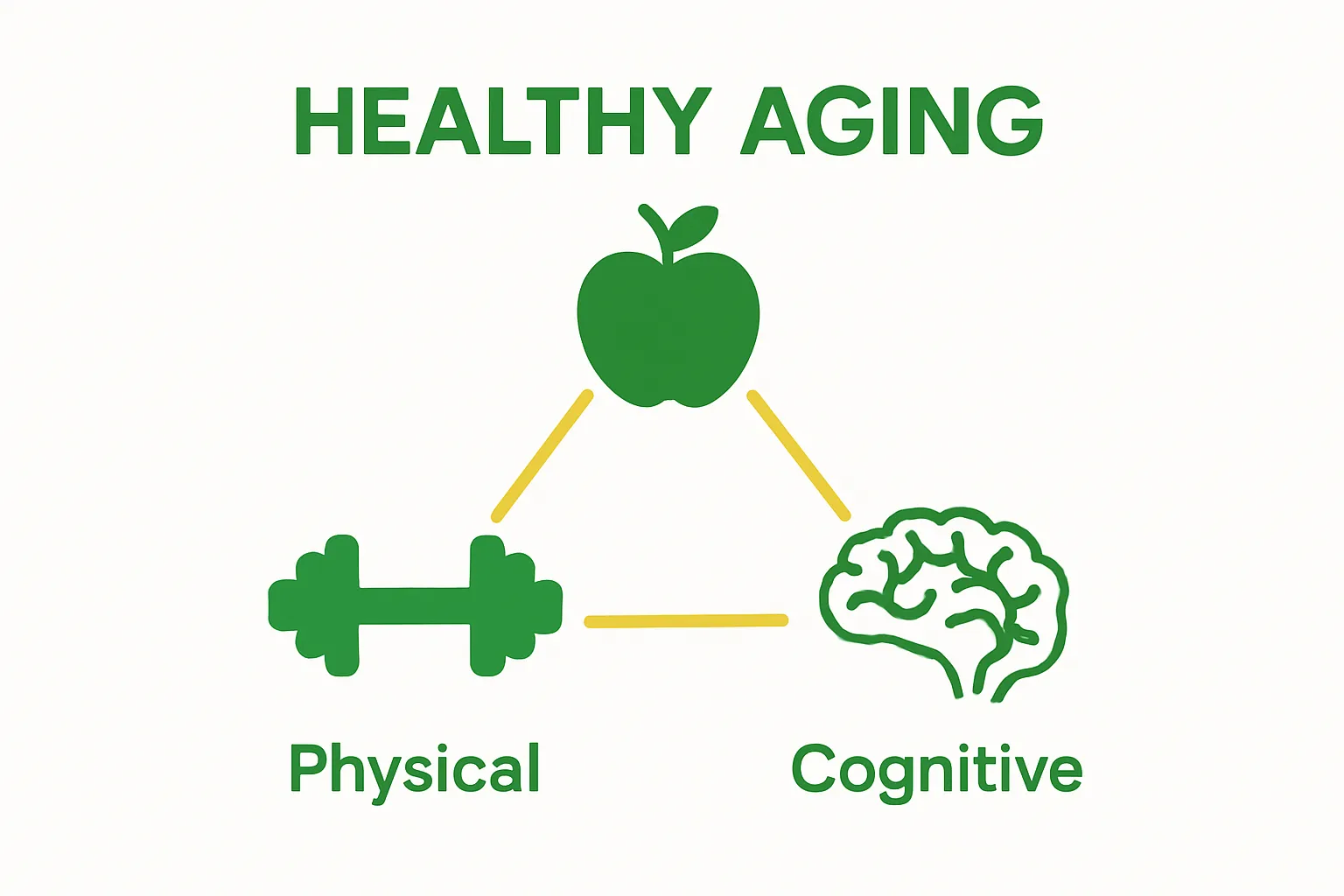Healthy aging is changing the way we think about getting older. In fact, the World Health Organization reports that by 2030, 1 in 6 people worldwide will be aged 60 or older. Most people expect aging to mean constant decline. The truth is, recent science shows you can actually add years packed with energy, sharp thinking, and strong relationships if you make the right lifestyle choices.
Table of Contents
- What Is Healthy Aging And Why It Matters
- The Science Behind Healthy Aging
- Key Components Of A Healthy Aging Lifestyle
- The Role Of Nutrition In Aging Gracefully
- Technology’s Impact On Healthy Aging
Quick Summary
| Takeaway | Explanation |
|---|---|
| Healthy aging is a holistic process | It includes physical health, mental acuity, and social connectivity, going beyond merely disease absence. |
| Lifestyle choices affect biological aging | Regular exercise, balanced nutrition, and mental stimulation can significantly influence one’s aging process and resilience. |
| Nutrition is crucial for aging well | A balanced diet rich in antioxidants, omega-3s, and proteins can support cellular health and mitigate age-related decline. |
| Technology enhances healthy aging | Digital tools can support cognitive training, health monitoring, and social interactions, improving overall aging experiences. |
| Focus on proactive lifestyle management | Instead of reactive health measures, integrating wellness practices can empower individuals to optimize their aging journey. |
What is Healthy Aging and Why It Matters
Healthy aging is a comprehensive approach to maintaining physical, mental, and social well-being as individuals progress through later life stages. Unlike traditional perspectives that viewed aging solely as a period of decline, modern health sciences recognize it as a dynamic process of continuous adaptation and potential growth.
The Holistic Definition of Healthy Aging
Healthy aging transcends mere absence of disease. Research from the World Health Organization defines it as the process of developing and maintaining functional abilities that enable older adults to remain active, independent, and engaged in life. This multidimensional concept encompasses several critical aspects:
- Physical Health: Maintaining bodily strength, mobility, and resilience
- Cognitive Function: Preserving mental sharpness and emotional well-being
- Social Connectivity: Sustaining meaningful relationships and community involvement
Understanding the Significance of Proactive Aging
Healthy aging is not about preventing aging but optimizing the aging experience. Our guide on understanding metabolic age reveals that individuals can significantly influence their biological age through lifestyle choices. Proactive strategies like regular exercise, balanced nutrition, and mental stimulation can help counteract age-related physiological changes.
By adopting a holistic approach to healthy aging, individuals can enhance their quality of life, maintain independence, and continue contributing meaningfully to society. The goal is not just extending lifespan but ensuring those additional years are filled with vitality, purpose, and personal fulfillment.
The Science Behind Healthy Aging
Healthy aging is far more complex than a simple chronological progression. Modern scientific research reveals intricate biological mechanisms that determine how we age, offering unprecedented insights into the aging process and potential interventions.
Cellular Mechanisms of Aging
Research from the National Institutes of Health highlights several fundamental processes driving age-related changes at the cellular level. These molecular transformations fundamentally impact our physiological resilience and functional capacity:
The following table summarizes the key cellular mechanisms of aging described in the article and how they impact overall health as we age.
| Cellular Mechanism | Description | Impact on Aging |
|---|---|---|
| Telomere Shortening | Chromosomal end-caps decrease in length with cell division | Reduced cell replication and tissue renewal |
| Mitochondrial Dysfunction | Energy-producing cellular components become less efficient | Lower energy, decreased cell function |
| Oxidative Stress | Accumulated molecular damage from free radicals | Impaired cellular function, faster aging |
- Telomere Shortening: Chromosomal end-caps gradually decrease in length with each cell division
- Mitochondrial Dysfunction: Energy-producing cellular components become less efficient
- Oxidative Stress: Accumulated molecular damage from free radicals impairs cellular function
Genetic and Environmental Interactions
Healthy aging emerges from a sophisticated interplay between genetic predispositions and environmental influences. Our guide on understanding metabolic age demonstrates how lifestyle choices can dramatically influence biological aging processes. Epigenetic modifications triggered by diet, exercise, stress management, and social engagement can effectively modulate gene expression.
Understanding these intricate biological pathways empowers individuals to make informed decisions. The science of aging is no longer about passive acceptance but active engagement with our body’s complex regenerative and adaptive capabilities.
Key Components of a Healthy Aging Lifestyle
A healthy aging lifestyle is a strategic, holistic approach to maintaining vitality and well-being throughout later life stages. It encompasses multiple interconnected dimensions that work synergistically to support physical, mental, and emotional health.
Pillars of Comprehensive Wellness
Research from the World Health Organization underscores that successful aging requires a multifaceted strategy. The key components include physical activity, nutritional balance, cognitive engagement, and social connectivity. These pillars are not isolated practices but deeply interrelated systems that collectively contribute to overall wellness:
- Physical Resilience: Regular exercise, strength training, and flexibility practices
- Nutritional Optimization: Balanced diet rich in nutrients and antioxidants
- Cognitive Stimulation: Continuous learning and mental challenge activities
Lifestyle Integration and Holistic Approach
Healthy aging is about proactive lifestyle management rather than reactive health interventions. Our guide on creating a healthy lifestyle emphasizes the importance of personalized strategies that adapt to individual needs and capacities. By integrating physical activity, proper nutrition, stress management, and meaningful social interactions, individuals can significantly enhance their quality of life and functional independence.
To help clarify the main areas that make up a healthy aging lifestyle, the table below summarizes the core pillars and their key characteristics discussed in the article.
| Pillar | Description |
|---|---|
| Physical Resilience | Regular exercise, strength training, and flexibility practices |
| Nutritional Optimization | Balanced diet rich in nutrients and antioxidants |
| Cognitive Stimulation | Continuous learning and mental challenge activities |
| Social Connectivity | Maintaining meaningful relationships and community involvement |
| Stress Management | Incorporating techniques to reduce and manage daily stress |
The goal is not merely extending years but adding life to those years. Each lifestyle choice represents an investment in long-term well-being, creating a comprehensive framework for vibrant, purposeful aging.
The Role of Nutrition in Aging Gracefully
Nutrition serves as a fundamental cornerstone in the journey of healthy aging, acting as a powerful modulator of cellular health, physiological function, and overall well-being. Beyond simply providing sustenance, strategic nutritional choices can significantly influence the aging process and mitigate age-related decline.
Essential Nutrients for Cellular Resilience
Research from the National Institutes of Health highlights the critical role of specific nutrients in maintaining age-related physiological functions. Targeted nutritional strategies can support cellular repair, reduce inflammation, and promote metabolic efficiency:
- Antioxidant-Rich Foods: Neutralize harmful free radicals and protect cellular structures
- Omega-3 Fatty Acids: Support brain health and reduce inflammatory responses
- Protein-Dense Sources: Maintain muscle mass and support metabolic function
Nutritional Strategies for Comprehensive Wellness
Our guide on understanding healthy eating strategies emphasizes the importance of a holistic approach to nutrition. Optimal aging nutrition is not about restrictive diets but about creating a balanced, nutrient-dense eating pattern that adapts to changing metabolic needs. By focusing on whole foods, minimizing processed ingredients, and maintaining proper hydration, individuals can support their body’s natural regenerative processes.
Nutrition represents a powerful lever in the aging process, offering individuals the opportunity to proactively influence their health trajectory through mindful dietary choices. The goal is not just longevity, but vibrant, functional living that celebrates the body’s remarkable adaptive capabilities.
Technology’s Impact on Healthy Aging
Technology has emerged as a transformative force in reshaping the aging experience, offering innovative solutions that enhance quality of life, support independence, and provide unprecedented opportunities for health monitoring and personal engagement.
Digital Tools for Cognitive and Social Wellness
Research from the National Institutes of Health demonstrates the significant potential of digital interventions in supporting older adults’ cognitive and emotional well-being. Technological innovations provide multifaceted support across various dimensions of aging:
- Cognitive Training Platforms: Online applications that stimulate mental acuity and memory function
- Telehealth Services: Remote medical consultations and health monitoring systems
- Social Connection Technologies: Digital platforms enabling meaningful interactions and reducing isolation
Integrated Health Monitoring and Personalization
Our guide on how technology is changing the way we cook and eat illustrates the broader implications of technological integration in health management. Wearable devices, smartphone applications, and artificial intelligence now offer personalized health insights, tracking everything from nutritional intake to physical activity, enabling more proactive and precise aging strategies.
Technology is not replacing human interaction but enhancing our ability to understand, manage, and optimize the aging process. By bridging medical expertise with personal empowerment, these digital tools are redefining what it means to age with grace, independence, and vitality.
Take Charge of Healthy Aging With Personalized Support
Are you striving to maintain independence, stay active, and make the most of every stage in life? If adapting your lifestyle for healthy aging seems overwhelming, you are not alone. Many readers like you face challenges putting dietary recommendations into practice or finding practical routines that suit their needs. This article highlights the importance of a comprehensive approach—balancing physical health, mental agility, nutrition, and social engagement. It is natural to want simple yet effective ways to implement these concepts and truly live a fulfilling life.
At Dietium.com, you can turn guidance into everyday action. Our Recipians app crafts custom meal plans and suggests recipes to help optimize nutrition at every age. Coupled with advanced AI tools for tracking your body metrics, dietary assessments, and fitness routines, you will have the support you need for holistic wellness. Discover the difference that real-time tracking, educational resources, and tailored fitness solutions can make. Visit Dietium.com now to begin your journey toward healthy aging. Take the first step—your path to more vibrant and independent years starts right here.
Frequently Asked Questions
What is healthy aging?
Healthy aging is a holistic approach that emphasizes maintaining physical, mental, and social well-being as individuals grow older. It goes beyond the absence of disease to focus on maintaining functional abilities that allow older adults to remain active and engaged in life.
How can I maintain cognitive function as I age?
To preserve cognitive function, engage in continuous learning and mental challenges, such as puzzles, reading, or educational courses. Additionally, maintaining social connections and participating in community activities can also enhance mental acuity.
What role does nutrition play in healthy aging?
Nutrition is vital for healthy aging, as it helps support cellular repair and reduces inflammation. A diet rich in antioxidants, omega-3 fatty acids, and protein can promote overall health and mitigate age-related decline.
How can technology assist in promoting healthy aging?
Technology offers innovative solutions such as cognitive training platforms, telehealth services, and social connection technologies that enhance cognitive and emotional wellness, allowing older adults to monitor their health and maintain social interactions.






